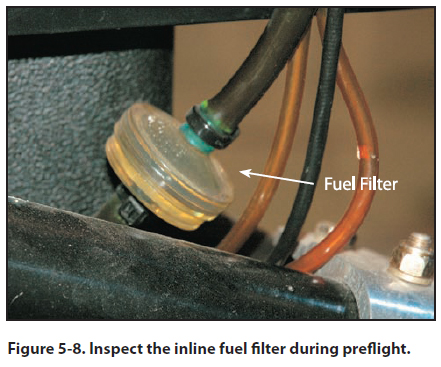|
Chapter 5 — Preflight and Ground Operations
Fuel and Oil
Pay particular attention to the fuel quantity, type,
grade, and quality. Many fuel tanks are sensitive to attitude
when attempting to fuel for maximum capacity.
The powered parachute attitude can also be affected
laterally by a ramp that slopes. Always confirm the
fuel quantity indicated on the fuel gauge(s) by visually
inspecting the level of the fuel tank(s).
The engine manufacturer recommends the type of fuel
that any given powered parachute engine should burn;
this recommendation should be strictly conformed to.
Although most PPC engine manufacturers recommend
premium grade auto fuel, it is usually acceptable
to burn 100LL AVGAS on a limited basis. Most
airports will not have auto fuel available on the field.
Ensure the fuel caps have been securely replaced
following each fueling and the vents are free and
open. Most powered parachutes have an inline fuel
filter located somewhere between the tank and the
carburetors; check the fuel filter for contaminates.
[Figure 5-8]

The fuel tank vent is an important part of all preflight
inspections. [Figure 5-9] Be alert for any signs of vent tubing damage, as well as vent blockage. A functional
check of the fuel vent system can be done simply by
opening the fuel cap. If there is a rush of air when
the fuel tank cap is opened, there could be a serious
problem with the vent system.

Check the oil reservoir to ensure the proper oil is
used. Check the oil level during each preflight and
after each refueling. [Figure 5-10] If the consumption
of oil steadily increases or suddenly changes, qualified
maintenance personnel should investigate. After
checking or adding oil to the PPC, ensure that the oil
cap has been securely replaced. The oil reservoir on a
two-stroke must be checked for adequate venting; if
this becomes plugged, it could cause starvation of the
oil to the engine.
Two cycle engines without oil injection premix the
oil with the fuel. Assure the mixture ratio is correct.
Proper mixing techniques is covered in the fuel section.
Powerplant Inspection
Inspect the propeller for any signs of propeller blade
chafing, and defects such as cracking. Check the propeller
for large nicks in the leading edge, cracks, pitting,
corrosion, and security. All propeller tape should
be securely attached to the propeller surface, paying
special attention to the convex side of the propeller
for any delaminating; propeller tape is used primarily
for protection on the leading edge of the propeller as
well as a supplemental balancing device. Check the
propeller hub for security, bolt threads showing and
general condition.
Powered parachute engines are set up in a pusher configuration,
so it is essential to check the engine area
for loose items to ensure nothing is blown through the
propeller, possibly injuring the aircraft, observers, or
property. Carburetor(s) must be checked to make sure
they are secure; check the air filter for condition and
secure fit. Check the rubber manifolds for cracks and
check spark plugs to make sure all of the spark plug
caps are secure. On some two-stroke engines, there
is a reservoir that contains the lubricant for the rotary
valve; check this level on every preflight. Check
gear reduction boxes for leaking seals and make sure
there is not play within the gears. Look for signs of
fuel dye which may indicate a fuel leak and deterioration
of fuel lines. Check for oil leaks, deterioration of
oil lines, and make certain that the oil cap, filter, oil
cooler and drain plug are secure.
Check the exhaust system for white stains caused
by exhaust leaks at the cylinder head or cracks in
the stacks. Check exhaust components for freedom
of movement; they must be secure with all exhaust
springs in place.
On liquid cooled engines, the radiator fluid level, as
well as the overflow reservoir, must be checked and
filled as necessary.
Check all visible wires and lines for security and condition.
|

